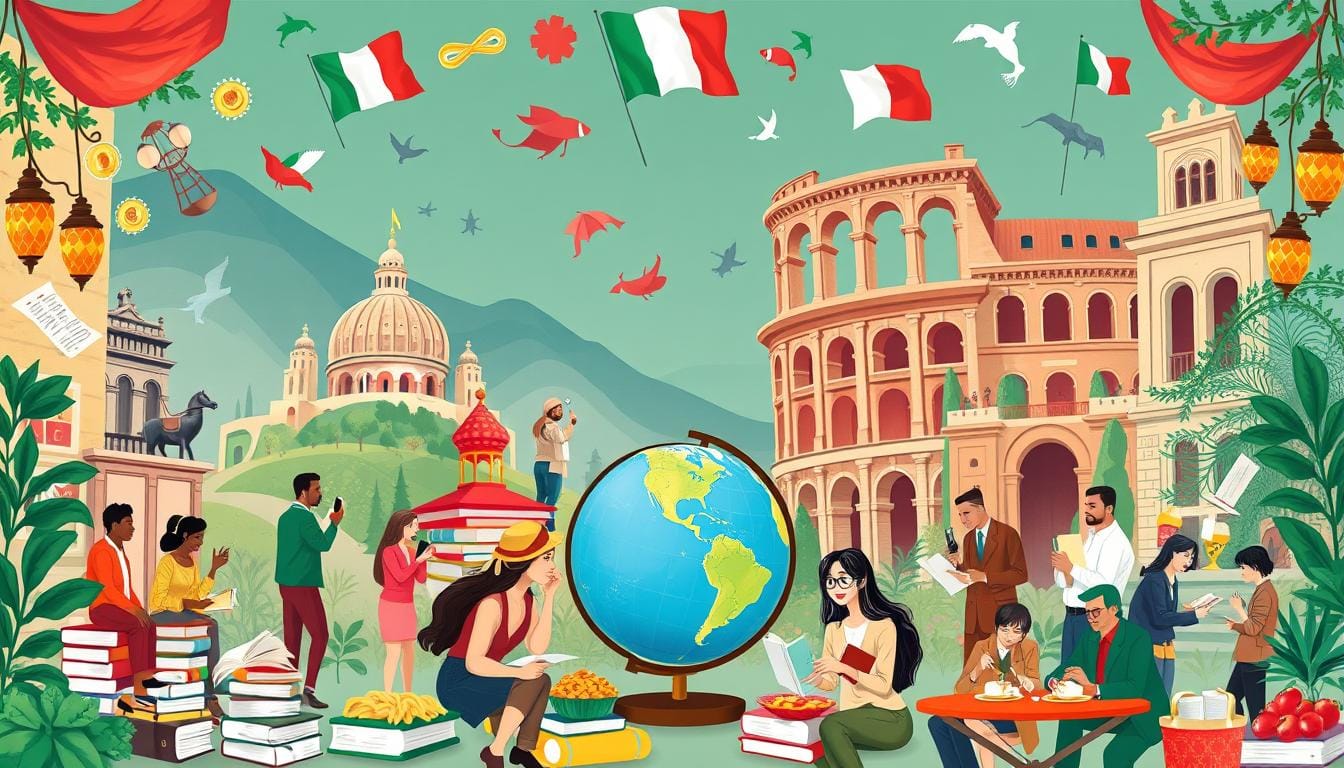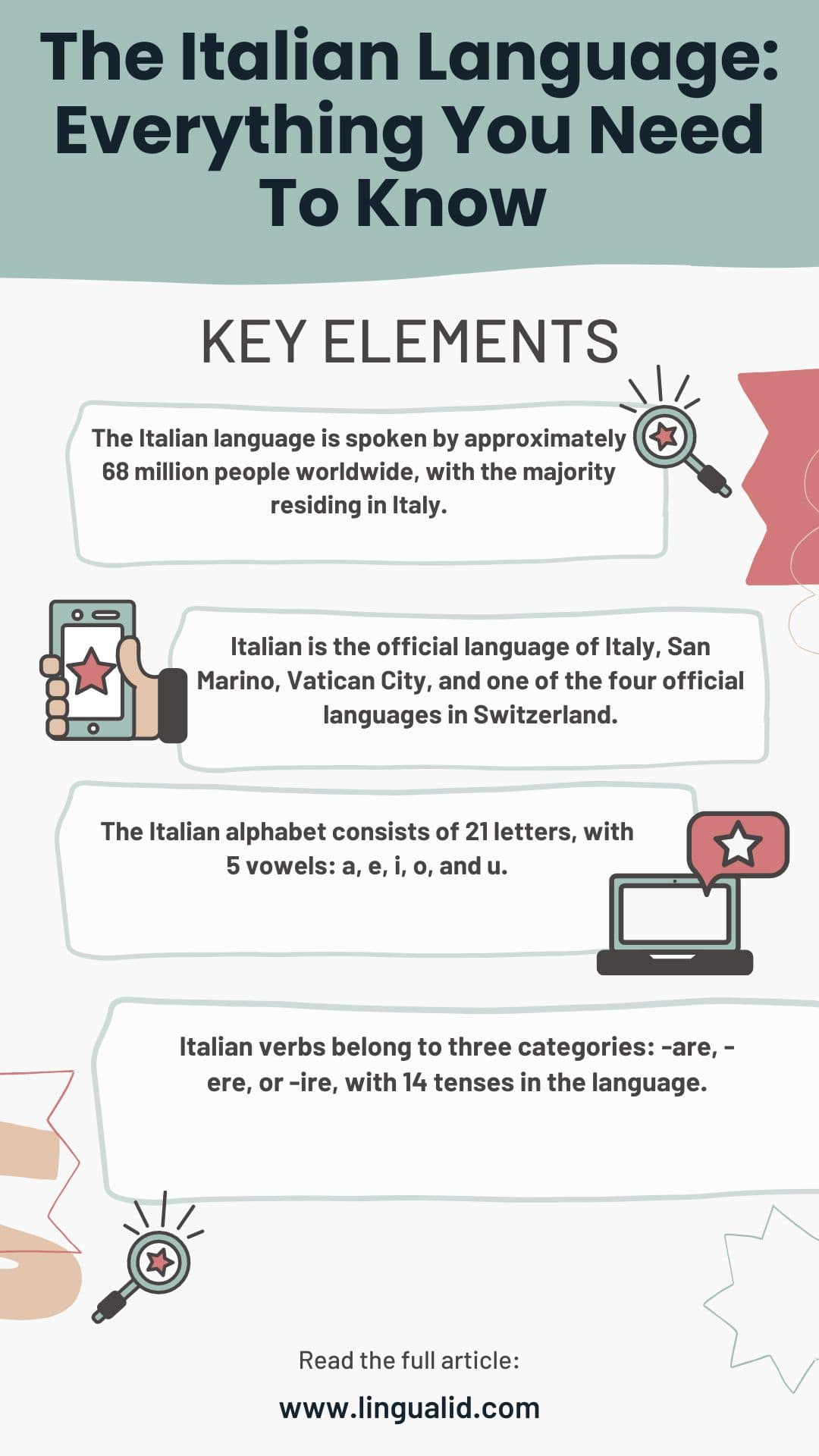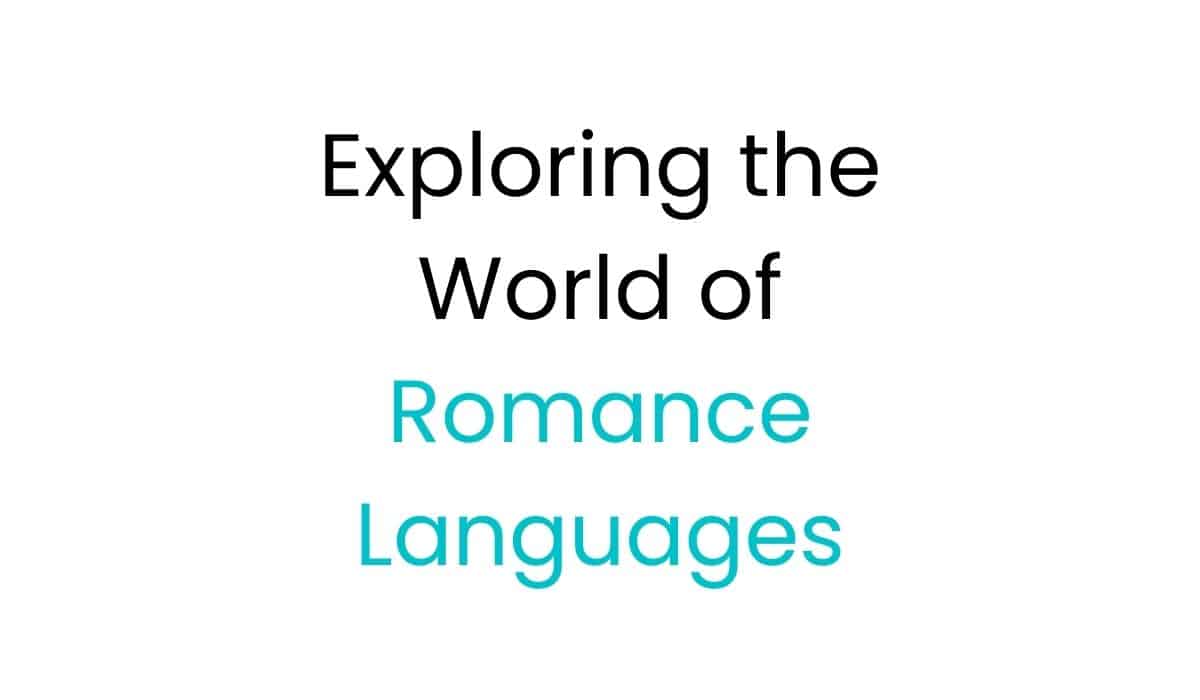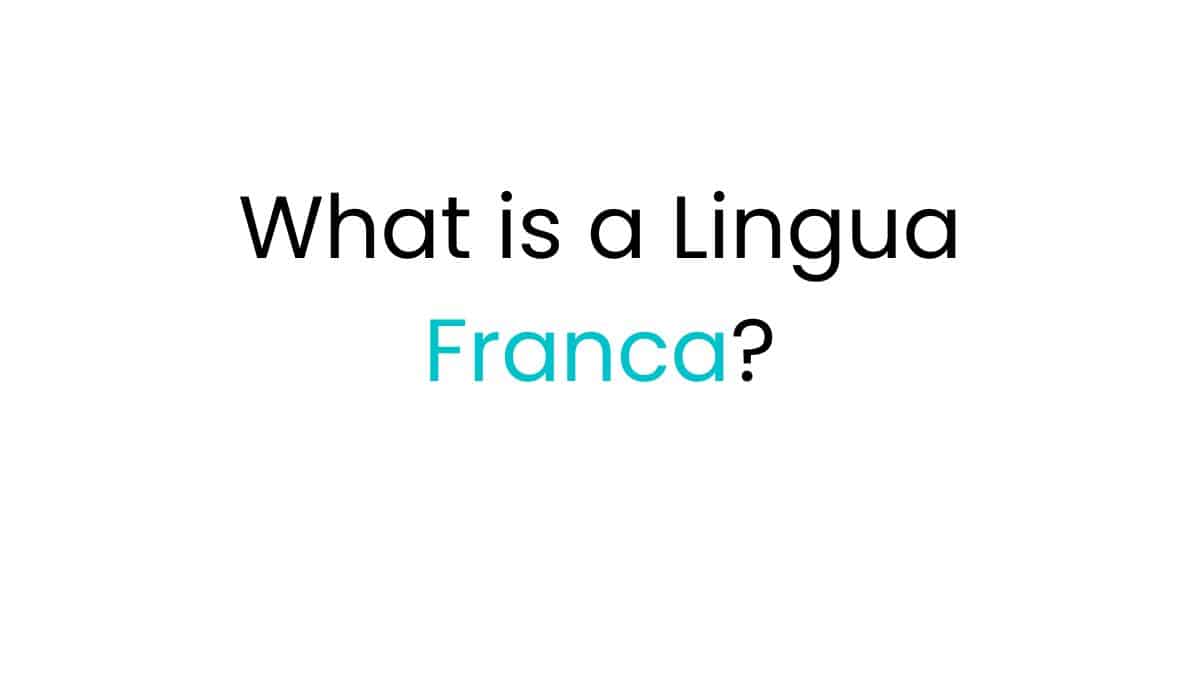The Italian language is both captivating and complex, with a deep history and cultural importance. This guide will cover the basics of Italian, including its history, dialects, grammar, pronunciation, and tips for learning. It’s perfect for language lovers, travelers to Italy, or anyone interested in this beautiful language.

Key Takeaways
- The Italian language is spoken by approximately 80 million people worldwide, with the majority residing in Italy.
- Italian is the official language of Italy, San Marino, Vatican City, and one of the four official languages in Switzerland.
- The Italian alphabet consists of 21 letters, with 5 vowels: a, e, i, o, and u.
- Italian verbs belong to three categories: -are, -ere, or -ire, with 14 tenses in the language.
- Italian nouns have two genders, masculine and feminine, with specific noun endings indicating gender.
Introduction to the Italian Language
Italian is a Romance language with deep roots in the Vulgar Latin spoken in Italy. It’s spoken by about 80 million people around the world. It’s the official language in Italy, San Marino, and Vatican City. It’s also used in parts of Switzerland, Slovenia, and Croatia.
This language has a rich history, shaped by Italian literature, art, and culture. It’s a language full of life and expression.
Overview of the Italian Language
Italian is closely tied to other Romance languages like French, Spanish, Portuguese, and Romanian. They all come from the same Vulgar Latin. Over time, Italian developed its own grammar, vocabulary, and way of speaking.
This shows the unique cultural and historical influences on the Italian peninsula.
Why Learn Italian?
Learning Italian has many benefits for personal and professional growth. It makes traveling in Italy more meaningful, letting you connect with locals. Italian is also tied to music, art, and literature, giving you access to a rich cultural heritage.
It’s also important in industries like fashion, design, tourism, and food. So, it can boost your career.
Studies show that learning a new language can improve your memory and help prevent Alzheimer’s and dementia. It could add 4 to 5 more years to your life. Italian is known for its beautiful sound and expressive nature. It’s a great choice for those looking to learn a new language.
Italian Language History and Origins
The Italian language has a rich history that goes back to Vulgar Latin, the common speech of the Roman Empire. As the empire grew, Latin spread, creating regional dialects. These dialects would later become the Romance languages, including Italian.
Brief History of Italian
In the 13th century, the Italian language started to come together. Dante Alighieri, Petrarch, and Boccaccio were key figures. They made the Florentine dialect the base of Standard Italian.
These famous writers helped spread and make Italian language popular. Their work helped make Italian widely known.
How Literature Shaped the Italian Language
The Italian literary tradition greatly influenced the language’s growth. Dante Alighieri’s Divine Comedy helped spread Italian across the peninsula. Later, poets like Petrarch and Boccaccio made Italian literature even more important.
In the 19th century, Alessandro Manzoni’s The Betrothed was a big step. It was written in Italian and made the Florentine dialect the official language. This was key in Italy’s unification.
The story of Italian shows how literature can shape and unite a language. From Dante Alighieri to Alessandro Manzoni, literature has been crucial. It has helped shape the Italian language into what we know and love today.
Italian Dialects and Regional Variations
Italy is known for its rich variety of regional dialects and accents. These add to the charm and complexity of the Italian language. Standard Italian is the main form of speech, but there are many local dialects with their own unique traits.
These dialects have developed over centuries, shaped by history, culture, and geography. From the melodic Sicilian to the expressive Neapolitan, each region has its own way of speaking. This shows the rich linguistic heritage of Italy.
- Tuscan is often seen as the “standard” Italian dialect, coming from Florence’s cultural heart.
- Sicilian stands out for its unique grammar and melodic tones.
- Neapolitan is known for its sing-song rhythm and heavy use of contractions.
- Venetian is famous for its rich local idioms and expressions.
- Lombard has a distinct nasal sound and lots of double consonants.
- Sardinian is the closest to Latin, with a special grammar.
- Romanesco, or the Roman dialect, is deeply connected to the city’s literary and theatrical history.
These italian dialects have greatly influenced the diversity of the italian language. They have also shaped the works of famous italian writers and poets. The regional accents in italy are celebrated for their role in the country’s cultural and linguistic richness.
“Each Italian dialect has its own unique grammar, pronunciation, idioms, and expressions that set them apart from the standard Italian language. Exploring these regional variations is essential for understanding the true depth and complexity of the Italian linguistic landscape.”
The Italian Alphabet and Pronunciation
The Italian alphabet is unique and different from the English one. It has 21 letters and doesn’t include J, K, W, X, and Y, which are mostly in loanwords and foreign names. The Italian language has a simple way of pronouncing words, where each letter usually makes one sound.
The Italian alphabet has diphthongs – two letters that make one sound. Knowing these diphthongs and how to pronounce them is key to speaking Italian well.
Italian Diphthongs and Pronunciation Rules
Italian has some tricky diphthongs for those learning the language. These include:
- Ai, as in Bai (bye)
- Ei, as in Sei (you are)
- Oi, as in Noi (we)
- Ui, as in Lui (he)
Also, letters like gn, gli, and sc have special sounds. For example, gn sounds like ny in Signore (Mr.), and gli sounds like ly in Iglia (eyelash).
| Italian Letter Combination | Pronunciation |
|---|---|
| C + A, O, U | Hard /k/ sound (as in Caldo – hot) |
| C + E, I | Soft /ch/ sound (as in Ciao – hello) |
| G + A, O, U | Hard /g/ sound (as in Gatto – cat) |
| G + E, I | Soft /j/ sound (as in Gelato – ice cream) |
Learning the italian alphabet, italian pronunciation rules, and italian diphthongs helps build a strong base. This way, learners can speak Italian with confidence.
Italian Grammar Essentials
The grammar of Italian is similar to other Romance languages, like having a subject-verb-object sentence structure. Italian verbs fall into three main types: -are, -ere, or -ire. The endings show how the verb changes. Also, nouns, articles, and adjectives must match in gender and number. While sentences are basic, learning about verb conjugation and agreement can be tricky.
Italian Sentence Structure
Italian sentences usually follow the subject-verb-object (SVO) pattern. This means the subject comes first, then the verb, and finally the object. For example, “Io mangio il gelato” (I eat the ice cream). But, the rules of agreement with nouns and adjectives can make sentences more complicated.
Verbs in the Italian Language
Verbs are key in the Italian language, with many tenses and ways of changing. They are grouped by their endings: -are, -ere, and -ire. While -are verbs are mostly regular, -ere and -ire verbs can be tricky. Italian also uses auxiliary verbs like avere (to have) and essere (to be) for compound tenses. Knowing how to change verbs is crucial for speaking Italian well.
| Verb Ending | Verb Category | Examples |
|---|---|---|
| -are | First Conjugation | Parlare (to speak), Amare (to love) |
| -ere | Second Conjugation | Vedere (to see), Credere (to believe) |
| -ire | Third Conjugation | Partire (to leave), Finire (to finish) |
Related post: Top Reasons To Learn Italian
Italian Nouns and Their Genders
Italian nouns are divided into two main genders: masculine and feminine. Knowing the gender of a noun is key. It helps with articles, adjectives, and pronouns.
Most nouns ending in -o are masculine, and those ending in -a are feminine. For example, il ragazzo (the boy) is masculine, and la ragazza (the girl) is feminine.
But, not all nouns follow this rule. Those ending in -e can be either masculine or feminine. You might need to remember or use context to figure out their gender. For instance, il padre (the father) is masculine, while la madre (the mother) is feminine.
Some nouns don’t fit the usual gender patterns. Words about people and animals can have the opposite gender. For example, il papà (the dad) and la mano (the hand) are masculine and feminine, even though they end differently.
| Noun Ending | Gender | Examples |
|---|---|---|
| -o | Masculine | il libro (the book), il gatto (the cat) |
| -a | Feminine | la scuola (the school), la casa (the house) |
| -e | Masculine or Feminine | il padre (the father), la madre (the mother) |
Knowing the gender of Italian nouns is key to the language. It’s important to learn the patterns and exceptions. With practice, you’ll get better at it and improve your Italian skills.
The Italian Language: Articles and Adjectives
Learning about articles and adjectives is key to getting good at Italian. Italian has definite articles like “the” which change based on the noun’s gender and number. For masculine singular nouns, use il, l’, or lo. For feminine singular nouns, use la or l’. Plural nouns get i and gli for masculine and le for feminine.
Definite Articles in Italian
Using definite articles correctly is important for making sentences right. For example, tavolo (table) gets il, while sedia (chair) gets la.
Indefinite Articles in Italian
Indefinite articles in Italian are simpler than definite ones. For masculine nouns, use un or uno based on the noun’s sound. For feminine nouns, use una or un’ before vowels. Knowing these helps you speak Italian better.
Italian Adjectives
Italian adjectives must match the noun’s gender and number. They usually end like the nouns they describe. Masculine adjectives often end in -o, and feminine ones in -a. This rule is key for making correct phrases and sentences.
Learning about Italian articles and adjectives helps you communicate better. It also connects you with the language’s rich culture.
Learning the Italian Language
Learning Italian opens up many doors, from better job chances to diving deep into Italy’s rich culture. If you’re just starting or want to get better at Italian, there are lots of tools to help you.
Useful Resources for Learning Italian
There are many ways to study Italian, from interactive courses to fun apps. Here are some great options:
- Language courses, both in-person and online, that provide structured lessons and personalized feedback from experienced instructors.
- Italian language apps like Babbel, which offer tailored lessons, voice recognition technology for improving pronunciation, and personalized progress tracking.
- Language exchange programs that connect you with native Italian speakers, allowing you to practice conversational skills and immerse yourself in the language.
- Study abroad programs or language immersion trips to Italy, where you can fully immerse yourself in the language and culture.
With so many Italian language resources available, you can get a deep understanding of the language and culture. This will make you better at speaking Italian.
“Learning a new language is like embarking on a thrilling journey of self-discovery, where every step unveils the nuances and beauty of a culture.”
Whether you want to learn Italian for fun, to get ahead in your career, or to connect with your heritage, there are tools to help you reach your goals.
The Musicality of the Italian Language
The Italian language is famous for its musical quality. This comes from its intonation and how words are pronounced. Words in Italian often end with the second-to-last syllable, making them sound musical. This has made Italian a key language for music, with terms like “tempo” and “soprano” coming from it.
By the seventeenth century, Italian was seen as a noble language. It’s unique because most words end with a vowel and uses double consonants. This makes it sound musical and lyrical. Italian poetry also uses a technique called elision, which changes the rhythm and syllable length, adding to its musical quality.
Piero Bembo believed in 1525 that sound, number, and variation make Italian beautiful. This idea has lasted through the ages. Italian was seen as the heart of European culture before the Renaissance. Its impact on classical music is huge.
For over a thousand years, Italian has been linked with music. Terms like “allegro” and “viola” come from Italian. The work of Italian monk Guido D’Arezzo in 1200 and the start of opera in Florence in 1550 made Italian the language of music.
Great composers like Mozart chose Italian for their operas. Terms like moderato and names for instruments like piano show how Italian is tied to music. This connection has lasted through time.
| Statistic | Fact |
|---|---|
| Italian’s appreciation as a noble language | Achieved in the seventeenth century |
| Opinion of Piero Bembo in 1525 | Sound, number, and variation contribute to the beauty of composition in Italian |
| Italian was referred to as the language of European culture | During the pre-Renaissance era |
| Italian monk Guido D’Arezzo invented modern musical notation | Around 1200 |
| Opera was born in Florence | Around 1550 |
“The Italian language is renowned for its melodic and musical qualities, which can be attributed to its intonation and pronunciation.”
Italian Language Tips for Travelers
Visiting Italy can be more fun if you know some Italian. Learning a few key phrases shows respect for the culture. It also helps you connect better with the locals.
It’s important to know about regional dialects in Italy. Each area has its own way of speaking Italian. This means different words, sounds, and rules. Learning these can make your trip smoother and avoid mix-ups.
Italian language has formal and informal ways to talk. You use Lei with strangers or older people. Tu is for close friends and family. Knowing when to use these forms shows respect and makes a good impression.
| Basic Italian Phrases for Travelers | Useful Italian Phrases for Specific Situations |
|---|---|
| Buongiorno (Good morning) Grazie (Thank you) Prego (You’re welcome) Arrivederci (Goodbye) Per favore (Please) | Scusi, può aiutarmi? (Excuse me, can you help me?) Dove si trova…? (Where is…?) Quanto costa? (How much is it?) Mi dispiace, non capisco. (I’m sorry, I don’t understand.) Chiamate un’ambulanza! (Call an ambulance!) |
Using italian language for travelers, basic italian phrases, italian etiquette, and knowing regional italian dialects will help you in Italy. You’ll feel more confident and enjoy your trip more.
The Italian Language and Culture
The Italian language is deeply connected to Italy’s rich culture. It has shaped and kept alive through literature and music. Works by Dante, Petrarch, and Boccaccio have touched hearts worldwide.
Italian isn’t just for art and books. It’s also key to Italy’s famous food. Many dishes and terms come from this language. It also impacts fashion and design, making Italy a global cultural leader.
Italian Language in Art and Literature
Dante Alighieri, known as the “Father of the Italian Language,” used it to create timeless works. His poem, “The Divine Comedy,” shows the language’s power. Poets like Petrarch and Boccaccio also left a lasting impact on literature.
Italian Language and Cuisine
Italian and food go hand in hand. Words like broccoli, zucchini, and pasta come from this language. Food is a big part of Italian life, bringing people together.
Italian Language and Fashion
Italian fashion is known worldwide. Brands like Gucci, Prada, and Versace set the standard for style. The language also gave us terms like moda and couture.
The link between Italian and its culture shows how language shapes a nation. From literature to fashion, Italian keeps the culture alive. It’s a key part of Italy’s identity.

Conclusion
The Italian language is both captivating and full of opportunities. It has a rich history and many different ways of speaking. It’s connected to Italian art, literature, and food, showing the country’s deep culture.
Learning Italian lets you appreciate the Italian lifestyle more. It opens doors to new experiences, whether you’re traveling, learning, or moving ahead in your career. It’s key in fields like fashion, hospitality, international business, and the arts.
Mastering Italian is a journey that’s both fun and rewarding. It’s great for anyone, from experts to beginners. It improves how you communicate and helps you understand Italy’s vibrant culture better. By learning Italian, you join a legacy that touches people everywhere.
FAQ
What is the Italian language?
Italian is a Romance language that comes from Vulgar Latin. It’s the official language in Italy, San Marino, and Vatican City. It’s also spoken in parts of Switzerland, Slovenia, and Croatia.
Why should I learn the Italian language?
Learning Italian has many benefits. It makes traveling in Italy better, lets you enjoy its rich culture, and is useful in fashion, design, and tourism industries.
What is the history of the Italian language?
Italian started from Vulgar Latin. Over time, it grew. Writers like Dante Alighieri, Petrarch, and Boccaccio helped make the Florentine dialect the standard Italian.
How diverse are the dialects in the Italian language?
Italy has many regional dialects and variations. Each region has its own dialect. These can be very different in how they sound, use words, and structure sentences.
What are the key features of Italian pronunciation?
Italian is known for its beautiful sound. This comes from putting the stress on the last syllable of most words and its unique vowel sounds.
What are the essential grammar rules in the Italian language?
Italian grammar is similar to other Romance languages. It has a simple sentence structure, many verb forms, and agrees with nouns and adjectives by gender and number.
What resources are available for learning the Italian language?
There are many ways to learn Italian. You can take classes, use apps, join language exchange programs, or go on study trips to Italy.
How is the Italian language connected to Italian culture?
Italian is deeply tied to Italy’s culture. It’s seen in literature, food, and has shaped fashion and design industries.
Oualid Cheddadi is the founder of Lingualid, a platform that inspires independent language learners worldwide, regardless of the language they are learning. The name “Lingualid” is derived from the Portuguese word for “language,” “língua,” and the last three letters of Oualid’s name, “Lid.”



